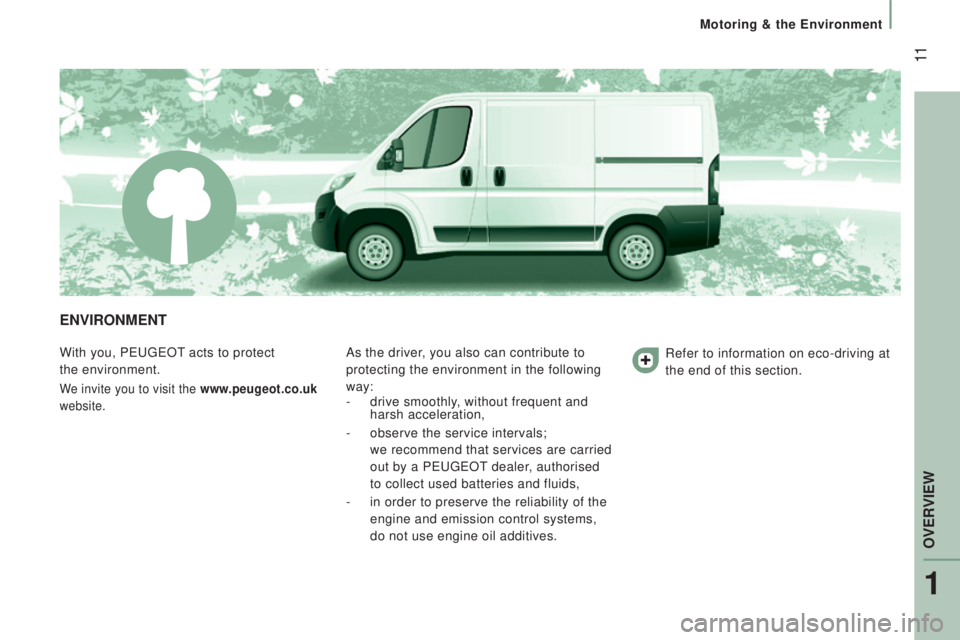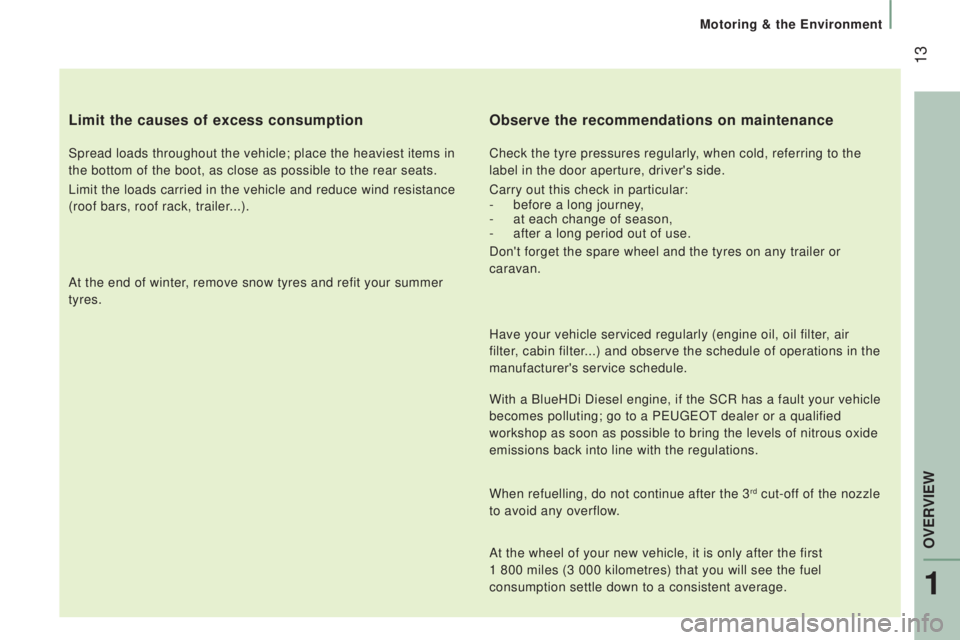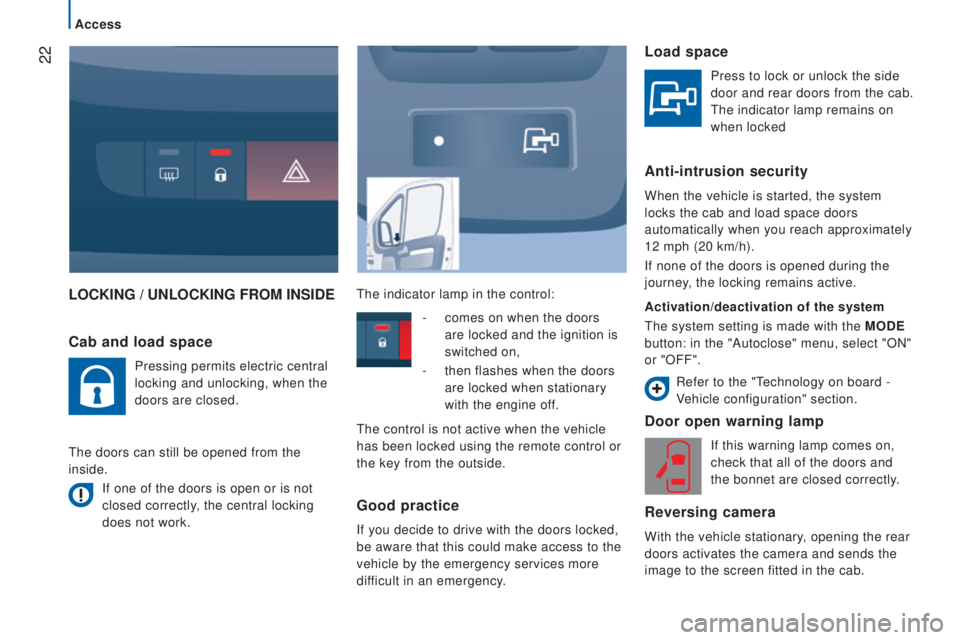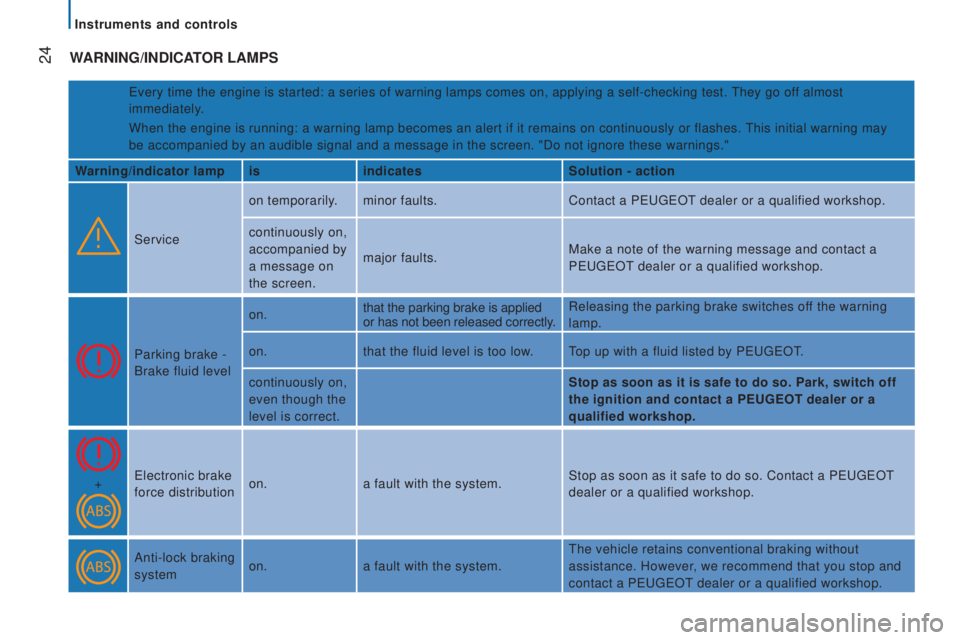2015 PEUGEOT BOXER service
[x] Cancel search: servicePage 2 of 276

On-line handbook
Select one of the following means of access to view your
handbook on-line...
Find your handbook on the Peuge
Ot we
bsite, under
"My Peuge
Ot".
Re
ferring to the handbook on-line also gives you access to the latest information available, easily identified by the bookmark, associated
with this symbol: If the "My
Peuge
Ot" fu
nction is not available on the
Peuge
Ot pu
blic website for your country, you can find your
handbook at the following address:
http://public.servicebox.peugeot.com/ddb/ the language,
the vehicle, its body style,
the print edition of your handbook appropriate for the date of
registration of your vehicle.
Select:
Scan this code for direct access to your handbook.
Page 4 of 276

2
contents
3. EASE oF uSE and coMFort 44-86
Lighting control stalk 45
Wipers 48
Cruise control 49
Speed limiter 55
Demisting and defrosting
59
Heating / Manual air conditioning
61
Digital air conditioning 63
Additional heating systems
65
Rear Heating / Air Conditioning
65
Programmable additional heating
67
Front seats 71
Front bench seat 73
Rear seats 74
Front fittings 76
Rear fittings 81
Exterior fittings 84
Mirrors 85electric windows 86
Presentation
4exterior 6
Interior 7
Instruments and controls 9technical data - Maintenance 10environment 1
1
eco-driving 12
1. oVErVIEW 4-13 4. tEcHnoLoGY on
BoArd 87-97
Vehicle configuration 87trip computer 92tachograph 93
Rear parking sensors 94
Reversing camera 95
Pneumatic suspension 96
2. rEAdY to SEt oFF 14-43
Remote control 14
Key 16
Alarm 19
Front / rear doors 20
Load space 22
Instrument panel 23
Warning/indicator lamps 24
Fuel gauge 32temperature indicator 32
Tyre under-inflation detection
33
Service indicator 35gearbox and steering
wheel 36gear shift indicator 36
Starting and switching of
f
38
Hill start assist 39
Stop & Start 40
Driving recommendations
43
this symbol informs you
of equipment which is
specific to the Combi
/
Minibus model. Child lock.Rear heating / air
conditioning / Rear
seats / bench seats.
Reading lamps. Sliding
side windows.
Page 13 of 276

11
EnVIronMEnt
With you, PeugeOt acts to protect
the
environment.
We invite you to visit the www.peugeot.co.uk
website.
As the driver, you also can contribute to
protecting the environment in the following
way:
-
drive smoothly, without frequent and
harsh acceleration,
-
observe the service intervals;
we
recommend that services are carried
out by a P
eugeOt dealer, authorised
to collect used batteries and fluids,
-
in order to preserve the reliability of the
engine and emission control systems,
do not use engine oil additives. Refer to information on eco-driving at
the end of this section.
1
OVeRVIeW
Motoring & the environment
Page 15 of 276

13
Limit the causes of excess consumption
Spread loads throughout the vehicle; place the heaviest items in
the bottom of the boot, as close as possible to the rear seats.
Limit the loads carried in the vehicle and reduce wind resistance
(roof bars, roof rack, trailer...).
At the end of winter, remove snow tyres and refit your summer
tyres.
observe the recommendations on maintenance
Check the tyre pressures regularly, when cold, referring to the
label in the door aperture, driver's side.
Carry out this check in particular:
-
before a long journey,
- at each change of season,
- after a long period out of use.
Don't forget the spare wheel and the tyres on any trailer or
caravan.
Have your vehicle serviced regularly (engine oil, oil filter
, air
filter, cabin filter...) and observe the schedule of operations in the
manufacturer's service schedule.
With a BlueHDi Diesel engine, if the SCR has a fault your vehicle
becomes polluting; go to a P
eugeOt dealer or a qualified
workshop as soon as possible to bring the levels of nitrous oxide
emissions back into line with the regulations.
When refuelling, do not continue after the 3
rd cut-off of the nozzle
to avoid any overflow.
At the wheel of your new vehicle, it is only after the first
1
800 miles (3 000 kilometres) that you will see the fuel
consumption settle down to a consistent average.
1
OVeRVIeW
Motoring & the environment
Page 20 of 276

18ELEctronIc IMMoBILISEr
All of the keys contain an electronic
immobiliser device.
this device locks the engine supply system.
It is activated automatically when the key is
removed from the ignition. Operating the remote control, even when it
is in your pocket, may result in involuntary
unlocking of the doors.
the simultaneous use of other high
frequency equipment (mobile telephones,
domestic alarms…), may interfere with the
operation of the remote control temporarily.
the remote control does not operate while
the key is in the ignition, even if the ignition
is off, except for reinitialisation.
Good practice
Make a careful note of the key number. If the
keys are are lost, it will be easier for your
P
eugeOt dealer to help if you can supply
this number and the confidential card.
Do not make any modifications to the
electronic immobiliser system.
this warning lamp is switched of
f
after the ignition is switched on
and the key has been recognised,
the engine can be started.
If the key is not recognised, the engine
cannot be started.
use another key and
have the faulty key checked by a P
eugeOt
dealer. After the ignition is switched on, a dialogue
is established between the key and the
electronic immobiliser system.
conFIdEntIAL cArd
this is given to you on delivery of your
vehicle with the duplicate keys.
It contains the identification code necessary
for any work carried out by a P
eugeOt
dealer on the electronic immobiliser system.
this code is hidden by a film, which should
be removed only if necessary.
Keep your card in a safe place, never inside
the vehicle.
When undertaking a long trip or journey,
however, it is advisable to take it with you
along with your personal papers.
When purchasing a second-hand vehicle:
-
ensure that you are given the
confidential card,
-
have the keys memorised by a
P
eugeOt dealer to ensure that the
keys in your possession are the only
ones which can start the vehicle.
Driving with the doors locked may
make access to the passenger
compartment by the emergency services
more difficult in an emergency.
As a safety precaution (with children on
board), remove the key from the ignition
when leaving the vehicle, even for a short
time.
Access
Page 24 of 276

22
LocKInG / unLocKInG FroM InSIdEd
oor open warning lamp
If this warning lamp comes on,
check that all of the doors and
the bonnet are closed correctly.
reversing camera
With the vehicle stationary, opening the rear
doors activates the camera and sends the
image to the screen fitted in the cab.
cab and load space
Pressing permits electric central
locking and unlocking, when the
doors are closed.
the doors can still be opened from the
inside.
If one of the doors is open or is not
closed correctly, the central locking
does not work.
the indicator lamp in the control:
Load space
Press to lock or unlock the side
door and rear doors from the cab.
the indicator lamp remains on
when locked
Anti-intrusion security
When the vehicle is started, the system
locks the cab and load space doors
automatically when you reach approximately
12 mph (20 km/h).
If none of the doors is opened during the
journey, the locking remains active.
Activation/deactivation of the system
the system setting is made with the
M
odE
button: in the "Autoclose" menu, select "ON"
or "OFF".
-
comes on when the doors
are locked and the ignition is
switched on,
-
then flashes when the doors
are locked when stationary
with the engine off.
the control is not active when the vehicle
has been locked using the remote control or
the key from the outside.
Good practice
If you decide to drive with the doors locked,
be aware that this could make access to the
vehicle by the emergency services more
difficult in an emergency. Refer to the "
technology on board -
V
ehicle configuration" section.
Access
Page 25 of 276

23
1. Distance recorder in miles / kilometres.
2.
Screen.
3.
Fuel gauge.
4.
Coolant temperature.
5.
Rev counter.
InStruMEnt PAnEL d
isplay screen
In the lower part:
-
time,
-
Ambient temperature,
-
Miles / Kilometres travelled,
-
t
rip computer (range, fuel
consumption...),
-
Headlamp beam height,
-
Programmable overspeed warning,
-
Cruise control or speed limiter,
-
g
ear shift indicator
,
-
Stop & Start.
In the upper part:
-
Date,
-
Service indicator,
-
Alert messages,
-
System status messages,
-
Vehicle configuration.
2
rEAdY to SEt oFF
Instruments and controls
Page 26 of 276

24WArnInG/IndIcAtor LAMPS
every time the engine is started: a series of warning lamps comes on, app\
lying a self-checking test. they go off almost
immediately.
When the engine is running: a warning lamp becomes an alert if it remain\
s on continuously or flashes.
this initial warning may
be accompanied by an audible signal and a message in the screen. "Do not\
ignore these warnings."
Warning/indicator lamp isindicates Solution - action
Service on temporarily. minor faults.
Contact a P
eugeOt dealer or a qualified workshop.
continuously on,
accompanied by
a message on
the screen. major faults.
Make a note of the warning message and contact a
P
eugeOt dealer or a qualified workshop.
Parking brake -
Brake fluid level on.
that the parking brake is applied
or has not been released correctly. Releasing the parking brake switches off the warning
lamp.
on. that the fluid level is too low.
top up with a fluid listed by PeugeOt.
continuously on,
even though the
level is correct. Stop as soon as it is safe to do so. Park, switch off
the ignition and contact a PE
uGEot dealer or a
qualified workshop.
+
electronic brake
force distribution on.
a fault with the system. Stop as soon as it safe to do so. Contact a P
eugeOt
dealer or a qualified workshop.
Anti-lock braking
system on.
a fault with the system.
the vehicle retains conventional braking without
assistance. However, we recommend that you stop and
contact a P
eugeOt dealer or a qualified workshop.
Instruments and controls